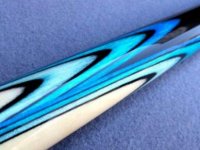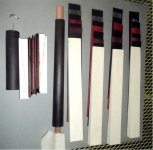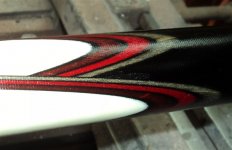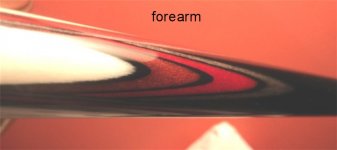In regards to butterfly cues and some veneer pointed cues How come the veneers appear to "blend" with one another? They look fuzzy and bleed into one another. Mainly butterfly cues. For example if an ebony veneer is touching a lighten one in a butterfly the ebony looks like it bleeds over. Instead of a perfect smooth curve. Just fuzzy and feathered looking. Hope I described well enough in layman's terms
You are using an out of date browser. It may not display this or other websites correctly.
You should upgrade or use an alternative browser.
You should upgrade or use an alternative browser.
butterfly cues
- Thread starter apool_shark
- Start date
Here's an example of What I'm talking about. The lowest ebony looks like it's running over into the lighter color. While the blue veneers seem fuzzy and darker in color at the curve. Weird
beats me?????????????????????????
I don't have a lot of experience with butterfly points, having only just made my first blank. I do understand the geometry involved and that is most likely an extremely thin layer of glue that has soaked into the veneer during the initial lay up of the veneers. Keep in mind that those veneers and the glue holding them together have been cut at an extremely shallow angle so that a few thousandths of an inch thickness are stretched over a much larger span. That's my best guess.
Any material cut sufficiently thin will become transparent. On it's way to becoming transparent it first becomes translucent. What you are calling "ebony" is almost certainly black paper or black dyed veneer, but the dye is not "bleeding". The other veneers are transitioning from full thickness to a feather edge, and as they get thinner and thinner the black layer beneath starts to show through. The smoothness of the arched tip depends on the surface of the veneer prior to being glued up - rough surface = more "jagged" edge appearance, smooth surface = smoother edge to the arc.
TW
TW
thanks thomas, i didnt have time to go into it, but you nailed it.:thumbup:Any material cut sufficiently thin will become transparent. On it's way to becoming transparent it first becomes translucent. What you are calling "ebony" is almost certainly black paper or black dyed veneer, but the dye is not "bleeding". The other veneers are transitioning from full thickness to a feather edge, and as they get thinner and thinner the black layer beneath starts to show through. The smoothness of the arched tip depends on the surface of the veneer prior to being glued up - rough surface = more "jagged" edge appearance, smooth surface = smoother edge to the arc.
TW
black paper .007" thick
all veneers , except the blk paper ran thru drum sander
veneers on both buttsleeve and front are exact same thickness .032"
steeper angle cut on buttsleeve= shorter bfly
shallower cut on front= longer bfly
.007 paper equates to approx. 1/4" long bfly on forearm
on butt , about an 1/8th
Attachments
Last edited:
Any material cut sufficiently thin will become transparent. On it's way to becoming transparent it first becomes translucent. What you are calling "ebony" is almost certainly black paper or black dyed veneer, but the dye is not "bleeding". The other veneers are transitioning from full thickness to a feather edge, and as they get thinner and thinner the black layer beneath starts to show through. The smoothness of the arched tip depends on the surface of the veneer prior to being glued up - rough surface = more "jagged" edge appearance, smooth surface = smoother edge to the arc.
TW
I get it that the wood becomes so thin its transparent, maybe 1 cell thickness in the end.
I have a cue made by one of BHQ's mentors. Think of burnt pizza. If you look straight down on one of the points its jagged. If you look down the length of the butt its dead nuts perfect. No veneers, full splice, curly maple on birds eye.
Why? Is that last mm so thin it can't be seen straight on or something else going on?
pm sent..........I get it that the wood becomes so thin its transparent, maybe 1 cell thickness in the end.
I have a cue made by one of BHQ's mentors. Think of burnt pizza. If you look straight down on one of the points its jagged. If you look down the length of the butt its dead nuts perfect. No veneers, full splice, curly maple on birds eye.
Why? Is that last mm so thin it can't be seen straight on or something else going on?
pm sent..........
Check your email



